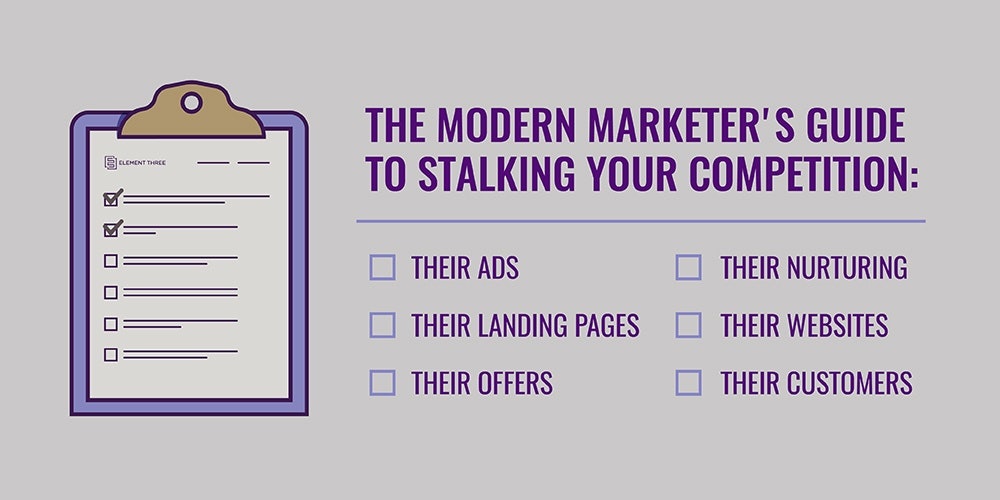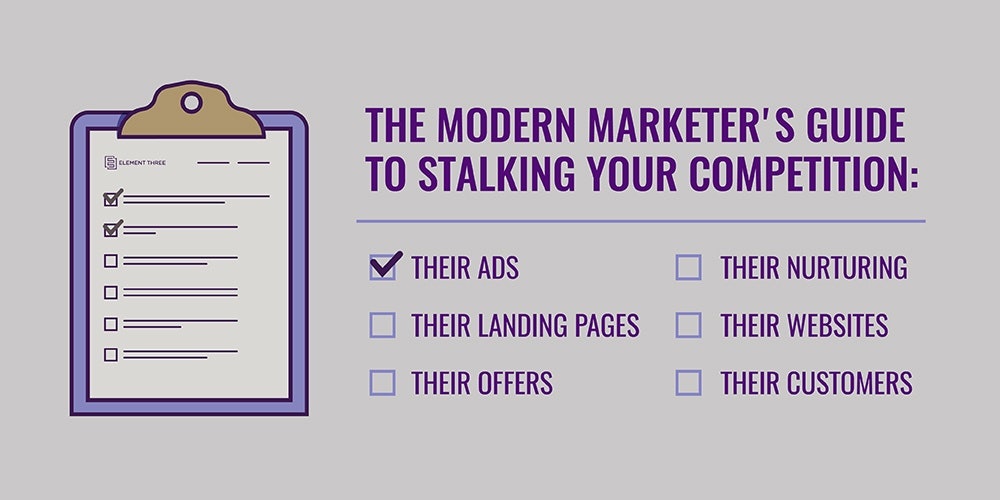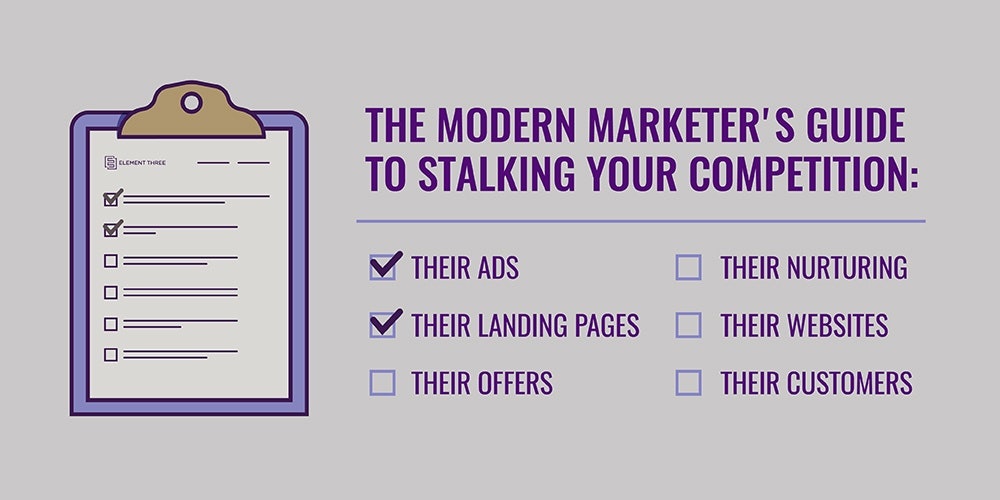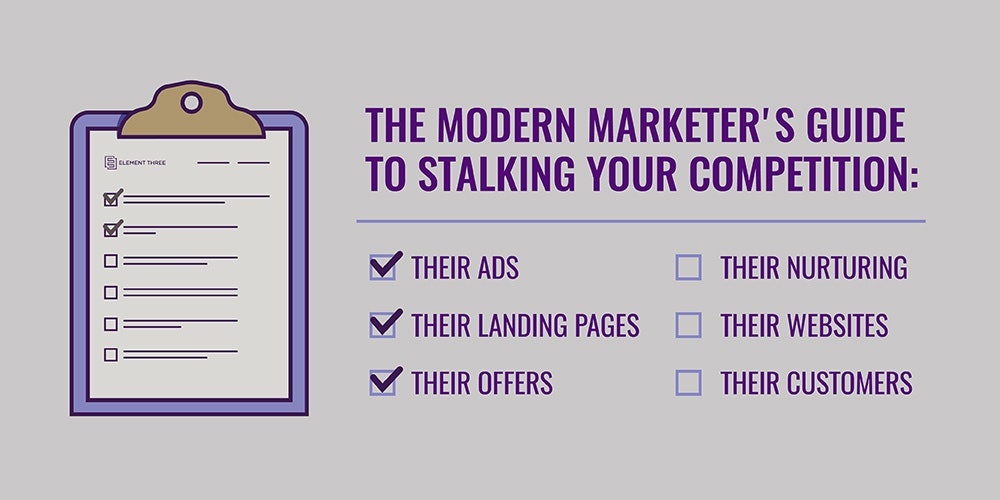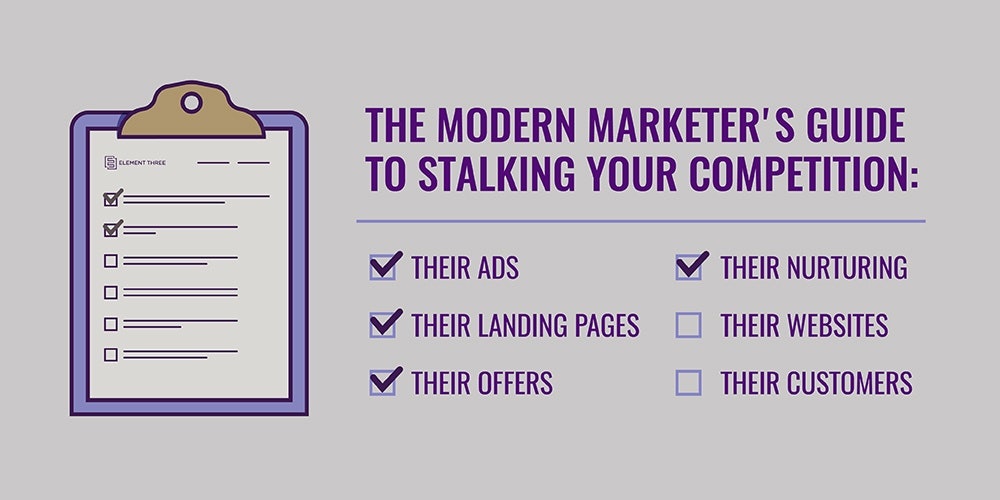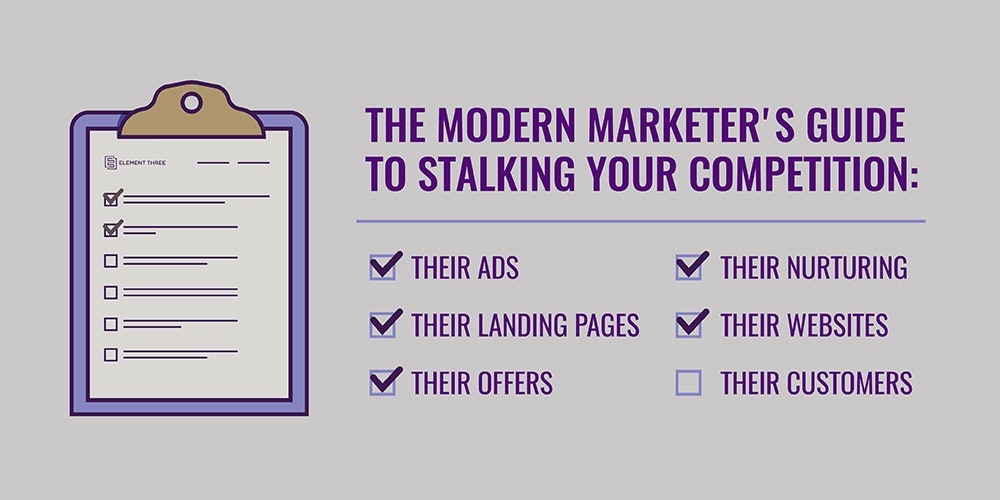This is the second post in a two-part series on how to identify your competition (which is not as easy as you may think) and successfully stalk them to learn from their successes and their mistakes. If you haven’t read Part 1, go do that now.
Once you’ve successfully identified your competition, including those indirect competitors that you’ve been ignoring, it’s time to take that landscape and do some competitive intelligence. Ladies and gentlemen, this is the modern marketer’s guide to stalking your competition.
Stalking Ads
One very clear way to learn from your competition, once it’s identified, is to stalk their advertising.
SEM Rush can give you insight into keywords that are being bid on by other companies and what their search ads look like, and can provide some insights into display and video ads too. Moat.com can show you display ads that other companies are running. And of course, you can always turn off your ad blocker, visit a competitor’s site and see how they retarget you.
When you view display ads – or create your own – always keep in mind the purpose of an awareness ad is to capture your attention, and the additional purpose of a conversion-based ad is to elicit action to click to the next step (not necessarily to sell the offer all by itself). These types of ads are based on attracting the goldfish – quick, simple, purposeful.
How are your competitors capturing your attention? What kinds of imagery are they utilizing? What kinds of messaging? What fonts…colors…layouts…sizes…there’s a nearly endless amount of ways to view and utilize what other ads are doing for consumers.
Likewise, with paid search (PPC) ads, you can get really granular into the ads themselves to learn a lot. What keywords do they appear to be optimizing for? What kind of language are they using? What features are they calling extra attention to? What is the offer to click for more information?
Knowing what you’re going up against for that precious attention span of your target buyer is crucial, and thankfully, it can be easy to sample and get ideas on what’s going on. And knowing is half the battle.
Stalking Landing Pages
Another way to learn more is to stalk competitor landing pages. The purpose here is absolutely to entice an action, be it form submission, download, education, video view, or something else. It should be measured at all costs (note for your own LPs), and you as a savvy marketer should be able to look at any great landing page and easily tell what the purpose of it is, and what they are likely measuring for success.
As you can already guess, there’s also a lot to learn here. How are the landing pages laid out? What’s the primary offer or purpose of the landing page? What kind of images are they using? Where is the form located? What fields are included in the form? What fields are required? What is being featured on the landing page? What font types? What messaging? How many words are on the page? And a dozen more questions, from button types to information architecture, mobile responsiveness and more.
There’s a lot to learn here, and like we said above regarding customer data, the same holds true here, too – qualitative and quantitative data are both valuable. You can learn a lot by looking at one competitor’s landing page, and you could learn a lot by analyzing 10 or 20 or 50 of them and looking for patterns. Be sure to lump like-minded things together – keep bottom-of-the-funnel offer pages together, and likely separate from brand awareness landing pages pitched much further up the funnel.
Stalking Offers
Broken record here, but looking at different offers across the funnel and across competitors can really reveal a lot about how those brands are going to market.
What are your competitors offering for downloadable content? At what stages are they offering content? When is it gated versus free to download or view? What kinds of mediums are they delivering that content in – ebooks, whitepapers, brochures, videos, webinars, podcasts, others? How extensive is it? Are there offers within the offers, like discounts or free trials or some other carrot to encourage the next step in the buying process?
And then you get into all of the content-specific questions around messaging, imagery, and other concerns listed above.
How do your offers compare? Are you featuring similar facets of your products or services? Does the content that your competitor is promoting match their brand? What kind of storytelling are they utilizing?
As you continue your analysis, you will likely see patterns emerge here, both within sections and then across brands. Creating a seamless experience can be quite important to maintaining brand equity and really creating an environment where your users feel at home.
Stalking Nurturing
What happens after you convert (on one of those form-specific or gated landing pages)? What is your experience like?
Did you get directed to a thank you page? What kind of content did it have on it? Did it have any extra goodies, or reinforce the content you just converted on? Were the layout, page architecture, and user experience similar or different?
Did you get a follow-up email? Did it include a link to the content you converted on? Other offers? A phone number? Was it personalized?
Did you get a follow-up phone call? How did the call go? What type of questions were asked? Was the caller looking to help you out, learn more about you, or sell you something – or a combination of the three?
Was there any other follow-up communication after the initial conversion, like a later email, call, ad, or something else that tried to re-engage your interest? What kind of details were included?
You can likely learn more than how competitors are following up on their leads – you may be able to learn what systems they’re using and how they are using them.
Stalking Websites
As you continue drilling down into the experience that your competitors are delivering online, ask yourself many of the same questions above. Has this competitor created a seamless experience? Do you feel self-propelled along a journey of discovering more about their brand, or are you being led by the nose to where they want you to go?
How does your experience so far stack up to other areas across their website? Is it driving towards the same purpose and goals, or are there many different journeys you could go on?
Do you feel like you know the company now – their goals, history, the noble why of their existence, and their customer service philosophy – or do you only know about the products they’re shilling?
Stalking Customers
You know I wouldn’t let you get away without talking about what we can learn from customers, now, didn’t you?
Every single question you just asked yourself as you took a journey throughout a competitor’s digital content experience is one that you could ask their customers. You also may be able to actually ask them similar questions about your competitors yourself, in focus groups and surveys.
You can also stalk them – I mean, listen to them – the same way you listen to your own customers, through product reviews, review websites, and social media. Look for content on the internet about your competition –- not on their websites, but on websites writing about them or in forums. What are users saying here? What kinds of questions, concerns, complaints, and accolades are customers expounding upon in the online space? How is the brand responding, and how are consumers responding to that?
What kinds of experience is this competitor sponsoring online? How does it relate? Can you guess what kinds of customers the brand is targeting? What do their ideal customers look and sound like, according to the messages, imagery, features and offers they promote?
How do your own marketing efforts compare?
How To Win In The Era of Information Overload
Now you know how to identify other competitors, besides the ones who directly compete with you. You know what kinds of things to look at when identifying competitors, and you know specifically the kind of questions to ask when analyzing the brand experience, product marketing, and social interaction of a specific brand.
You’ve got a lot of things to think about and by now, a couple thousand words into this blog post, you’re probably at information overload. But here are a few parting words to consider before we close the book on what you can learn from your competitors, both the ones close to home and far ahead, just dreams of desires in your target consumers’ minds.
Two tips, to bring it all back home.
The Royal Why
Look back over all the information you’ve gleaned, everything you’ve considered. Does your brand reflect the golden circle, with a Simon Sinek-approved Noble Why front and center among your brand experience? Could you define the Noble Why of any of the brands you considered competitors before? How about the new ones you learned to identify within these articles?
The key to changing the perceptions of the audience is twofold: committing to marketing from why you’re in business, the noble purpose for which you exist; and targeting the audiences that identify and believe in those same things, for whom that noble purpose isn’t just attractive but that rings true.
If you start to market this way, to evolve your brand into something greater than the revenue gained or the product sold; to the customers, employees, and the greater communities you serve, the perception of your brand will be much more TED and Red Bull and a lot less #justiceforbradswife in the market place.
The BS Detector
That said, please for the love of god, don’t try to fake a noble why. Today’s consumers aren’t necessarily any more or less savvy than before, per se. What they are is media-aware and media-available. They wield smartphones equipped with social media and apps that let them tell the world exactly when, where, and how you screwed up.
You can’t fake purpose, you can’t fake honesty. People are just too smart, and far too eager to join the mob, start a fire, and burn a brand down.
The only thing that will change a brand perception, or win over new customers, or launch a new product, or any other of a hundred activities you could partake on behalf of marketing your business, is hard work. Dig in, get scrappy, but prepare to go the extra mile to make something that matters. If it hurts, it’s likely because it’s off your noble why.
And as Pepsi, and even Cracker Barrel, can attest to, the price of doing it wrong is too high.
Dear God, Will This Ever End? Oh, It’s Over? Hooray!
You’ve made it, kind and gentle reader, past the snark, past Brad’s wife’s sudden unemployment, and past a cola-flavored disaster. Hopefully, you’ve got a million ideas firing at once, or if nothing else, the hunger to figure out what your consumers think about your brand or how your “other” competitors are attacking the marketing place.
If it all looks like too much to take on, have no fear. We’re here to help, so head over to our contact us form to get a conversation started, or check out our work to see what kinds of services we can offer, and how we’ve won at branding and digital marketing for brands just like yours.



